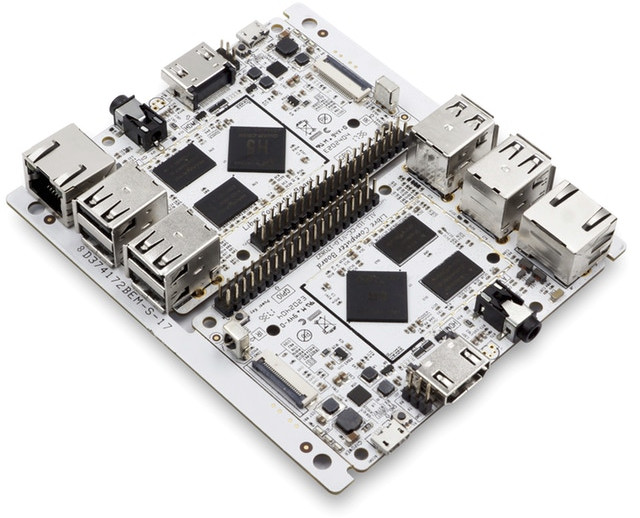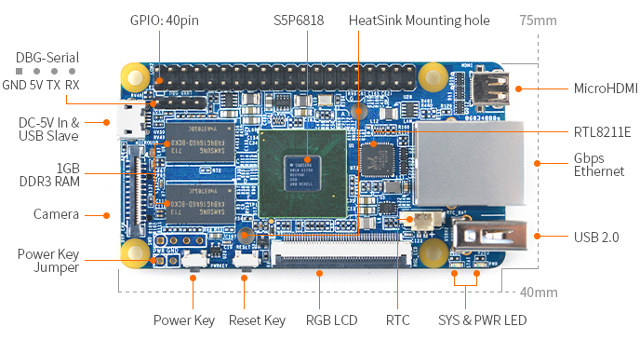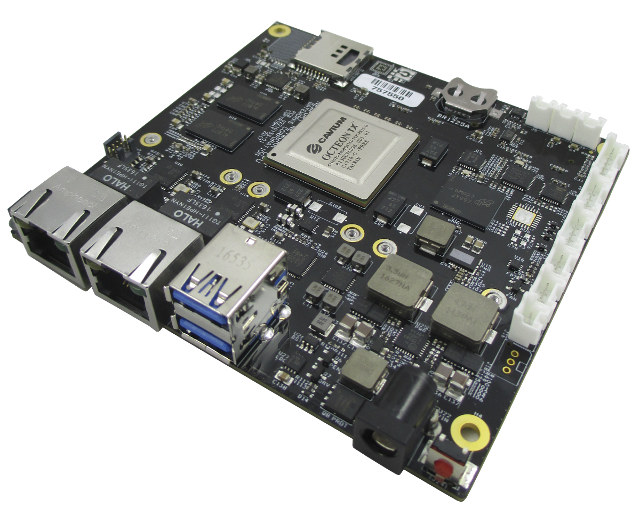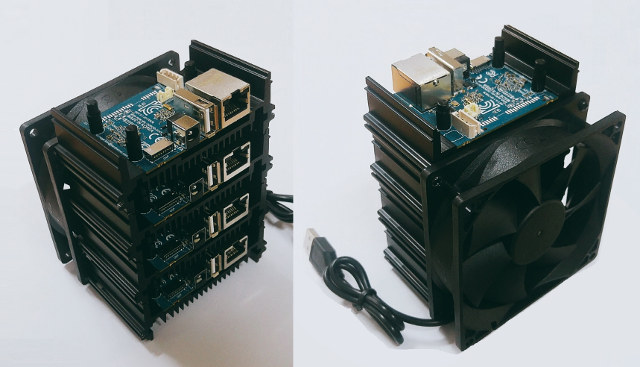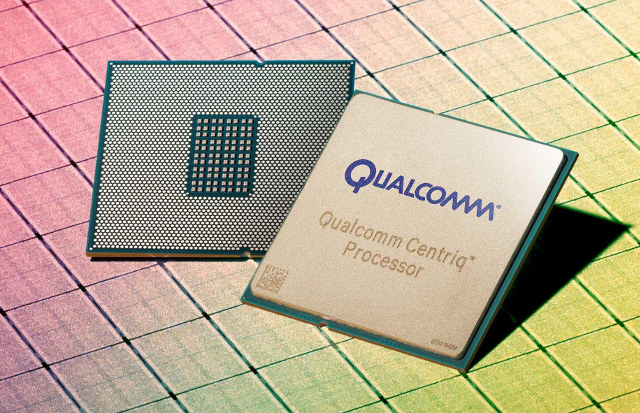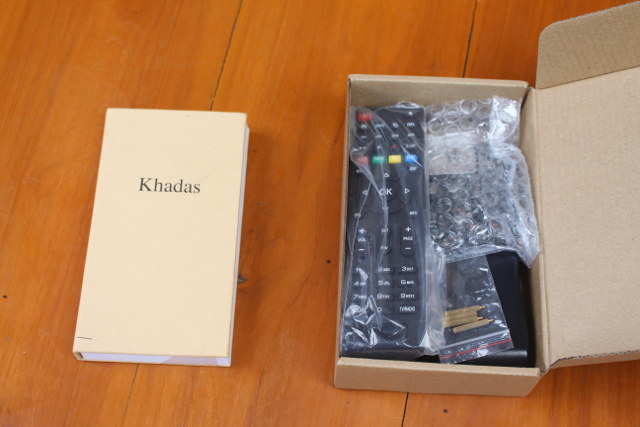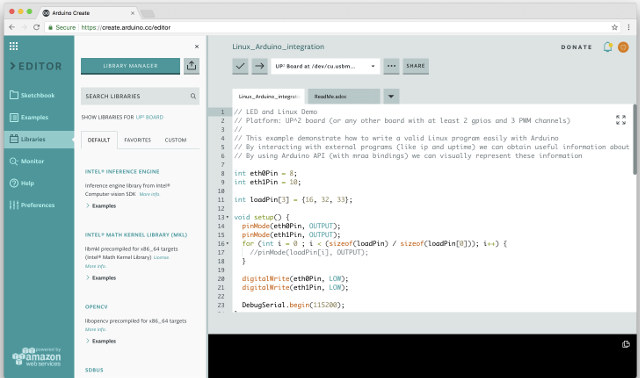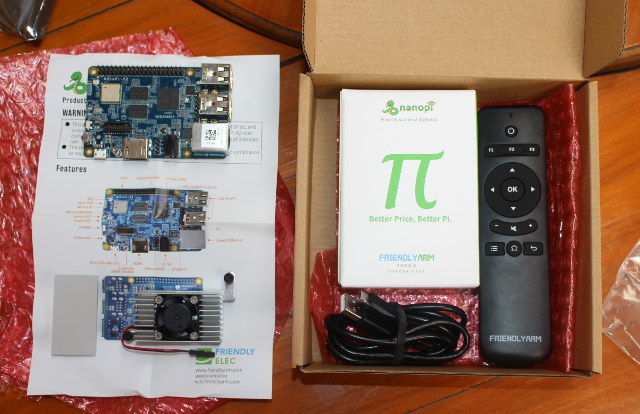A few months ago, Libre Computer introduced Le Potato board (aka AML-S905X-CC) powered by Amlogic S905X processor plus up to 2GB RAM, and using Raspberry Pi 3 form factor. The company is now back with three Tritium boards, using the same form factor, but instead powered by Allwinner H2+, H3, or H5 processors, with a lower price point as the Tritium IoT board (H2+ / 512 MB RAM) goes for $9 only. Tritium boards (ALL-H3-CC) specifications: SoC and Memory Tritium IoT – Allwinner H2+ quad core Cortex A7 processor with Mali-400MP2, 512MB DDR3 Tritium 1GB – Allwinner H3 quad core Cortex A7 processor with Mali-400MP2, 1GB DDR3 Tritium 2GB – Allwinner H5 quad core Cortex A53 processor with Mali-450MP4, 2GB DDR3 Storage – 1x micro SD Card slot, eMMC module connector Video & Audio Output Tritium IoT – HDMI up to 1080p60, AV port Tritium 1GB & 2GB – HDMI 1.4 […]
NanoPi Fire2A & Fire3 Boards Released with Samsung/Nexell Quad & Octa Core Processors
FriendlyElec previously launched NanoPi 2 Fire board powered by Samsung (Nexell) S5P4418 quad core Cortex A9 SoC, mostly interesting because of its small form factor, camera and LCD interfaces. The company has now launched two new boards based on S5Pxx18 processors, namely NanoPi Fire2A powered by S5P4418 SoC, and NanoPi Fire3 based on S5P6818 octa-core Cortex-A53 SoC. Both boards share the same form factor, which remains quite similar to the one of NanoPi 2 Fire, except the HDMI connector now makes place for a micro HDMI port, the USB 2.0 has moved into vertical position, and a few other tweaks have been made to positions of buttons and components. NanoPi Fire2A / Fire3 specifications: SoC Fire2A – Samsung S5P4418 quad core Cortex A9 processor @ up to 1.4GHz, Mali-400MP GPU Fire3 – Samsung S5P6818 octa core Cortex A53 processor @ up to 1.4 GHz, Mali-400MP GPU System Memory Fire2A – 512MB DDR3 […]
Gateworks Newport SBCs Powered by Cavium Octeon TX 64-bit ARM SoC are Designed for Networking Applications
Gateworks is a US based company that provides embedded hardware solutions to mobile and wireless communications markets such as their NXP i.MX6 powered Ventana single board computers, including Ventana GW5530 SBC with compact form factor making it suitable for robotics projects and drones. The company has now launched a new family of single board computers with Newport boards based on Cavium Octeon TX dual and quad core processors, and targeting high performance network applications with up to 5 GbE copper Ethernet ports, 2 SFP ports for fiber. Eight boards from 4 board designs using the dual or quad core version of the processors will be launched in sequence until Q2 2018, but let’s first have a closer look at Newport GW6300/GW6304 boards’ specifications since they are available now: SoC GW6300 – Cavium Octeon TX CN8020 dual core custom ARMv8.1 SoC @ 800 MHz GW6304 – Cavium Octeon TX CN8030 quad […]
ODROID-MC1 Quad Board Cluster Launched for $220
Hardkernel teased us with ODROID HC1 Home Cloud server, and ODROID MC1 cluster last August with both solutions based on a cost down version of ODROID-XU4 board powered by Samsung Exynos 5422 octa-core Cortex-A15/A7 processor. ODROID-HC1 Home Cloud server was launched shortly after in September for $49. It took a little longer than expected for the cluster to launch, but ODROID-MC1 (My Cluster One) is finally here with four ODROID-XU4S boards, and a metal case with a cooling fan. The solution is sold for 264,000 Wons in South Korea, and $220 to the rest of the world. ODROID-MC1 cluster specifications: Four ODROID-XU4S boards with SoC – Samsung Exynos 5422 quad core ARM Cortex-A15 @ 2.0GHz quad core ARM Cortex-A7 @ 1.4GHz with Mali-T628 MP6 GPU supporting OpenGL ES 3.0 / 2.0 / 1.1 and OpenCL 1.1 Full profile System Memory – 2GB LPDDR3 RAM PoP Network Connectivity – 10/100/1000Mbps Ethernet […]
Qualcomm Centriq 2400 ARM SoC Launched for Datacenters, Benchmarked against Intel Xeon SoCs
Qualcomm Centriq 2400 ARM Server-on-Chip has been four years in the making. The company announced sampling in Q4 2016 using 10nm FinFET process technology with the SoC featuring up to 48 Qualcomm Falkor ARMv8 CPU cores optimized for datacenter workloads. More recently, Qualcomm provided a few more details about the Falkor core, fully customized with a 64-bit only micro-architecture based on ARMv8 / Aarch64. Finally, here it is as the SoC formally launched with the company announcing commercial shipments of Centriq 2400 SoCs. Qualcom Centriq 2400 key features and specifications: CPU – Up to 48 physical ARMv8 compliant 64-bit only Falkor cores @ 2.2 GHz (base frequency) / 2.6 GHz (peak frequency) Cache – 64 KB L1 instructions cache with 24 KB single-cycle L0 cache, 512 KB L2 cache per duplex; 60 MB unified L3 cache; Cache QoS Memory – 6 channels of DDR4 2667 MT/s for up to 768 […]
Khadas VIM2 Board Review – Part 1: Unboxing and Dual Tuner Board
Khadas VIM2 board is the successor of Khadas VIM board, replacing Amlogic S905X by a slightly more powerful Amlogic S912, but that’s the connectivity features that really makes it stand apart from the first version with Gigabit Ethernet, 802.11ac WiFi and Bluetooth 4.2. It also exposes a few extra I/Os via pogopins. and among the three variants, two comes with 3GB RAM, and up to 64 GB storage. The company (Shenzhen Wesion) sent me one of the boards, together with various accessories, and I’ll start the review of the board by checking out the hardware and accessories, before testing the board further in another post. I received two packages: one book-like with Khadas marked on top, and another one with various other items. The first package includes the board, a USB to USB type C cable, and a card showing the main specifications, and supported operating systems: Ubuntu 16.04, Android […]
Arduino Create Adds Support for Linux Development Boards (based on Intel processors for now)
Most people are used to program Arduino compatible boards with the Arduino IDE that they’ve installed in their Windows/Linux/Mac OS computer, and manage everything locally. But Arduino introduced Arduino Create last year, which includes Arduino Web Editor allowing you to perform the same tasks in your web browser, and save your files in the cloud. The company has now added Linux support to Arduino Create so that users can now program their Linux devices as if they were regular Arduino boards, and easily deploy IoT applications with integrated cloud services. The initial release has been sponsored by Intel, and currently supports X86/X86_64 boards, but other hardware architectures will be supported in the coming month. In the meantime, AAEON UP2 board is the best platform to get started, as a complete getting started guide is available for the platform. But other mini PCs such as Intel NUC, Dell Wyse, Gigabyte GB-BXT are […]
Giveaway Week – NanoPi K2 Development Board
NanoPi K2 development board is powered by Amlogic S905 processor coupled with 2GB RAM, and follows Raspberry Pi 3 form factor, and I’ve got a K2 multimedia kit to give away courtesy of FriendlyELEC who sent me one a few months ago. The kit includes the board, a quick start guide, a fansink, a USB cable for power, an acrylic case (not shown above), and an IR remote control. I got it when I asked for NanoPi NAS Kit, and sadly I did not find the time to test it, but the company provides both Android 5.1 and Ubuntu 16.04.2 images for the board, and Armbian also released an experimental Ubuntu server image with mainline kernel, and an Ubuntu desktop “testing” image with legacy Linux. To enter the draw simply leave a comment below. Other rules are as follows: Only one entry per contest. I will filter out entries with […]


